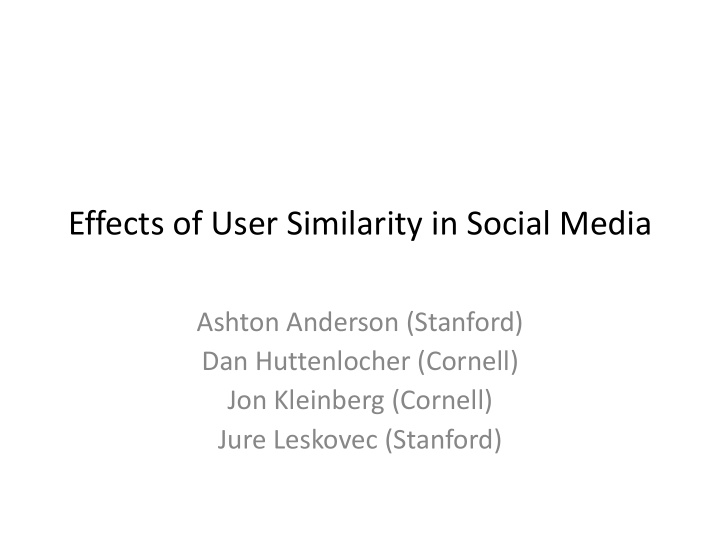



Effects of User Similarity in Social Media Ashton Anderson (Stanford) Dan Huttenlocher (Cornell) Jon Kleinberg (Cornell) Jure Leskovec (Stanford)
User-to-user evaluations Evaluations are ubiquitous on the web: – People-items: most previous work • Collaborative Filtering • Recommendation Systems • E.g. Amazon – People-people: our setting Direct Indirect
Where does this occur on a large scale? • : adminship elections – Support/Oppose (120k votes in English) – Four languages: English, German, French, Spanish • – Upvote/Downvote (7.5M votes) • – Ratings of others’ product reviews (1-5 stars) – 5 = positive, 1-4 = negative
Goal Understand what drives human evaluations ? A B Evaluator Target
Overview of rest of the talk 1. What affects evaluations? – We will find that status and similarity are two fundamental forces 2. This will allow us to solve an interesting puzzle – Why are people so harsh on those who have around the same status as them? 3. Application: Ballot-Blind Prediction – We can accurately predict election outcomes without looking at the votes
Roadmap 1. What affects evaluations? – Status – Similarity – Status + Similarity 2. Solution to puzzle 3. Application: Ballot-blind prediction
Definitions • Status – Level of recognition, merit, achievement in the community – Way to quantify: activity level • Wikipedia: # edits • Stack Overflow: # answers • User-user Similarity – Overlapping topical interests of A and B • Wikipedia: cosine of articles edited • Stack Overflow: cosine of users evaluated
How does status affect the vote? Pr[ + ]~ 𝑔 ( 𝑇 𝐶 ) Natural hypothesis: “Only attributes (e.g. status) of B matter”
How does status affect the vote? Pr[ + ]~ 𝑔 ( 𝑇 𝐶 ) Natural hypothesis: “Only attributes (e.g. status) of B matter” We find Pr[ + ]~ 𝑔 ( 𝑇 𝐵 − 𝑇 𝐶 ) Attributes of both evaluator and target are important “Is B better than me?” is as important as “Is B good?”
Relative Status vs. P(+) • Evaluator A evaluates target B • P(+) as a function of ∆ = 𝑇 𝐵 − 𝑇 𝐶 ? • Intuitive hypothesis: monotonically decreases Intuitive hypothesis Reality
How does similarity affect the vote? Two natural (and opposite) hypotheses: ↑ similarity ⇨ ↓ P(+) 1. “The more similar you are, the better you can understand someone’s weaknesses” ↑ similarity ⇨ ↑ P(+) 2. “The more similar you are, the more you like the person” Which one is it?
Similarity vs. P(+) Second hypothesis is true: ↑ similarity ⇨ ↑ P(+) Large effect
How do similarity and status interact? Subtle relationship: relative status matters a lot for low- similarity pairs, but doesn’t matter for high-similarity pairs Status is a proxy for more direct knowledge Similarity controls the extent to which status is taken into consideration
Who shows up to vote? We find a selection effect in who gives the evaluations (on Wikipedia): If , then A and B are highly similar 𝑇 𝐵 > 𝑇 𝐶 Wikipedia
What do we know so far? 1. Evaluations are diadic: Pr[ + ]~ f(S A − S B ) 2. ↑ similarity ⇨ ↑ P(+) 3. Similarity controls how much status matters 4. In Wikipedia, high-status evaluators are similar to their targets
Roadmap 1. How user similarity affects evaluations 2. Solution to puzzle 3. Application: Ballot-blind prediction
Recall: Relative Status vs. P(+) Reality Intuitive hypothesis Why?
Solution: similarity + Different mixture of P(+) vs. 𝑇 𝐵 − 𝑇 𝐶 curves produces the mercy bounce = On Stack Overflow and Epinions, no selection effect and a different explanation
Roadmap 1. How user similarity affects evaluations 2. Solution to puzzle 3. Application: Ballot-blind prediction
Application: ballot-blind prediction Task: Predict the outcome of a Wikipedia adminship election without looking at the votes Why is this hard? We can only look at the first 5 voters 1. We aren’t allowed to look at their votes 2. General theme: Guessing an audience’s opinion from a small fraction of the makeup of the audience
Features 1. Number of votes in each Δ-sim quadrant ( Q ) 2. Identity of first 5 voters (e.g. their previous voting history) 3. Simple summary statistics ( SSS ): target status, mean similarity, mean Δ * Note now we are predicting on a per-instance basis, so it makes sense to use per-instance features
Our methods Global method ( M1) : Pr [ 𝐹 𝑗 = 1 ] = 𝑄 𝑗 + d( ∆ 𝑗 , 𝑡𝑗𝑛 𝑗 ) Personal method ( M2 ): Pr [ 𝐹 𝑗 = 1 ] = α ∗ 𝑄 𝑗 ( ∆ 𝑗 , 𝑡𝑗𝑛 𝑗 ) + (1 − α ) ∗ d( ∆ 𝑗 , 𝑡𝑗𝑛 𝑗 ) • 𝐹 𝑗 : ith evaluation voter i’s positivity: historical fraction of positive votes • 𝑄 𝑗 : : global deviation from overall average vote fraction in • d( ∆ 𝑗 , 𝑡𝑗𝑛 𝑗 ) ( ∆ 𝑗 , 𝑡𝑗𝑛 𝑗 ) quadrant 𝑄 𝑗 ( ∆ 𝑗 , 𝑡𝑗𝑛 𝑗 ) : personal deviation • • α : mixture parameter
Baselines and Gold Standard • Baselines: – B1 : Logistic regression with Q + SSS Pr [ 𝐹 𝑗 = 1 ] = 𝑄 𝑗 + SSS – B2 : • Gold Standard ( GS ) cheats and looks at the votes
Results English Wikipedia German Wikipedia Implicit feedback purely from audience composition
Summary
Thanks! Questions?
Recommend
More recommend